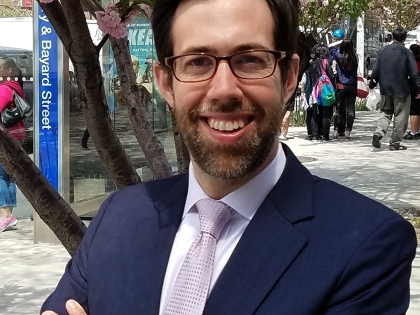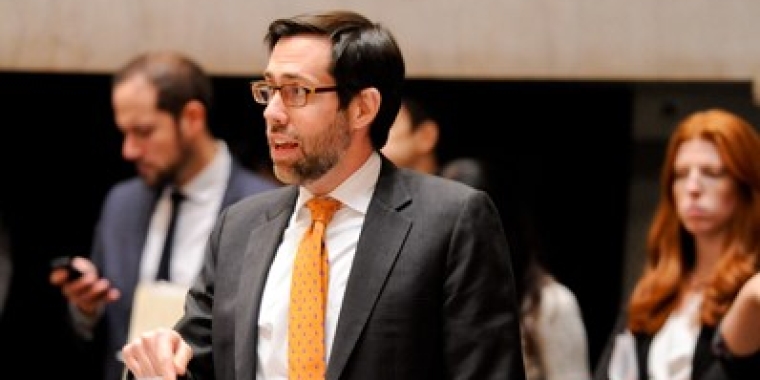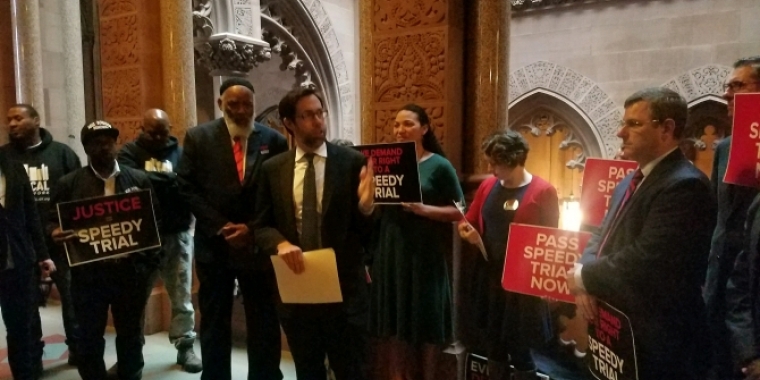
TESTIMONY OF STATE SENATOR DANIEL SQUADRON REGARDING THE DRAFT ANNUAL PLAN 2014 FOR THE NEW YORK CITY HOUSING AUTHORITY
Daniel L. Squadron
July 24, 2013
TESTIMONY OF STATE SENATOR DANIEL SQUADRON REGARDING THE DRAFT ANNUAL PLAN 2014 FOR THE NEW YORK CITY HOUSING AUTHORITY
July 24, 2013
My name is Daniel Squadron and I represent the 26th Senate District in the New York State Senate. My district includes the Brooklyn neighborhoods of Greenpoint, Williamsburg, Vinegar Hill, Fulton Ferry, Brooklyn Heights, Cobble Hill, Carroll Gardens and Gowanus, and the Manhattan neighborhoods of Tribeca, Battery Park City, the Lower East Side, Chinatown, the Financial District, Little Italy, SoHo and the East Village.
Among the New Yorkers that I represent are the approximately 26,000 residents of 19 New York City Housing Authority (NYCHA) developments, spanning the Lower East Side, East Village, and Chinatown. The developments in my district include the Bernard Baruch Houses, Marianna Bracetti Houses, East 4th Street Rehab, First Houses, Samuel Gompers Houses, Rafael Hernandez Houses, Fiorello H. LaGuardia Houses, Lower East Side I and II, Lower East Side Rehab (Group 5), Max Meltzer Tower, Henry Rutgers Houses, Seward Park Extension, Alfred E. Smith Houses, Stanton Street, Two Bridges, Vladeck Houses, Lillian Wald Houses, and 45 Allen Street.
The NYCHA FY 2014 Draft Annual Plan (Annual Plan) points to many of the challenges faced by the agency — significantly impacting 403,736 NYCHA tenants around the city. There are solutions, however, not included in the plan, which would go a long way to creating better conditions and quality-of-life for those tenants.
The Annual Plan reaffirms that NYCHA continues to experience “overwhelming funding shortages” with its annual funds “cut by 35% since 2001.” Chairman Rhea testified in front of the City Council Public Housing Committee in April this year, noting that NYCHA is currently running a structural operating deficit of sixty million dollars with a backlog of six billion dollars in capital repairs.
For years, I’ve been working with City, State and Federal officials and advocates to address the agency’s chronic funding challenges. Along with my colleagues, I established the SOUND Housing Campaign, a broad based coalition formed to support public housing and address NYCHA’s long-term financial needs. I was also proud to sponsor legislation in Albany "federalizing" city and state owned developments, allowing NYCHA to draw over $75 million annually in new federal operating funds and hundreds of millions of dollars for capital improvements.
There are additional actions that can be taken now to provide sufficient, reliable funding. For example, currently NYCHA pays over $70 million a year to the NYPD for “special police services,” making it the only residential landlord in the City that is required to pay for police protection. This decades-old administrative agreement has locked NYCHA into perpetual financial crisis and imposes what is essentially a regressive cost on NYCHA tenants. To be clear: safety in NYCHA developments is paramount and force strength must be maintained, but the existing agreement is a simple cost shift unrelated to those issues that unfairly burdens NYCHA and its residents. NYCHA should advocate to end the payment.
The Annual Plan states that we must find ways to “connect residents and communities to critical services.” I agree that providing support to the NYCHA residents that need it most must be a high priority, and that NYCHA must have an active, not just passive, role in connecting those services.
According to NYC Human Resources Administration data, approximately 500,000 people in the City are eligible for SNAP benefits (formerly called food stamps), but many do not claim them either because they are unaware of their eligibility or because of barriers to accessibility. There is considerable crossover between those that are eligible for SNAP benefits and those living in NYCHA housing.
It's time NYCHA do more to close that SNAP gap.
I propose a simple new program, “SNAP-APP”, that would integrate SNAP applications into the process of applying for NYCHA housing and lease renewals. There is no better time to ask a tenant to consider his or her needs and eligibility.
The Infill Land-Lease Proposal (Infill Proposal) is a significant funding source in the plan; it is also a critical local issue. Four of the eight proposed sites are in my district, and significantly impact 26,000 constituents living in NYCHA, as well as the surrounding communities.
The Annual Plan states that the Infill Proposal is “based on discussions with residents that began in 2006 with the development of the Plan to Preserve Public Housing,” which implies there has been a sufficient period of consultation and engagement with NYCHA residents on the plan. This is simply not the case. The Annual Plan's assertions are contradicted by my own experience and extensive feedback my office has received from community groups, community boards, residents, and resident associations affected by the plan.
While NYCHA is continuing to hold “resident and stakeholder meetings to discuss the lease of land,” the Annual Plan also states that NYCHA “plans to develop and issue a Request for Proposal (RFP) in the spring.” This approach to planning — where engagement and consultation occur as an apparent afterthought to a process that proceeds full steam ahead -- is unacceptable. I am opposed to the current Infill Proposal. It has lacked a true community process, as well as meaningful engagement with NYCHA residents and the community.
In the Annual Plan, NYCHA recognizes that “installing CCTV cameras deters crime and enhances the quality of life of its residents,” and asserts that the process of installation of cameras is moving forward.
I released a report with my colleagues Manhattan Borough President Scott Stringer and Assemblymember Brian Kavanagh in September of last year called “Protecting NYCHA Communities.” The report surveyed tenants’ concerns about public safety in ten developments on the Lower East Side. The results show that residents often fear for their safety and that housing developments lack basic protections, including functional locks for buildings, reliable intercom systems, and regular security patrols. These protections must be part of an increased security plan as well.
The safety and security of NYCHA residents is about protection from criminal activity; today we know that the ability of NYCHA to deal with the consequences of extreme weather events also fundamentally impacts residents’ safety and security.
My district, which surrounds the harbor, was hit hard by Sandy. After the storm, nearly 200,000 of my constituents, including significant numbers of NYCHA residents, were without power, heat, or hot water for days and in some cases weeks. I worked to coordinate volunteers to go door-to-door to reach the most vulnerable residents — with translators ahead of the mandatory evacuation and with supplies after the storm hit.
I was disappointed there was not a more comprehensive disaster preparedness analysis contained in the NYCHA Annual Plan. For example, although there were a number of references to emergency grants and funding NYCHA has received, there was little discussion of how that money would be spent. It is imperative given recent severe weather events, and the extent to which NYCHA did not have plans in place to deal with them, that the agency produce a truly comprehensive disaster preparedness plan and work with the community to implement it.
Thank you for the opportunity to testify today.
Share this Article or Press Release
Newsroom
Go to Newsroom


